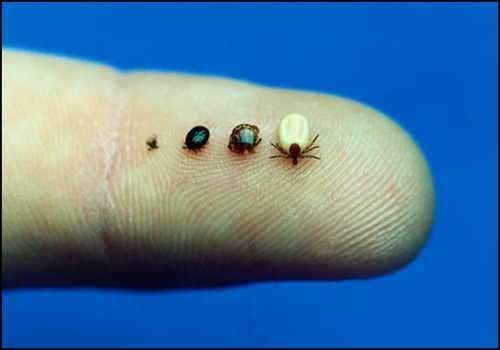Lyme Disease
Lyme Disease is caused by Deer Ticks (Black-Legged Ticks). It’s a serious threat to Casco Bay islanders who enjoy the outdoors. Deer Ticks are the most common carriers of Lyme disease, as well as similar diseases like Anaplasmosis and Babesia. Ticks require a blood meal before they can lay eggs. That could be you as they bite and inject the Lyme pathogen. Ticks follow your breath (CO2) they hang on plants. Ticks look like “moving freckles.” They do not fly; they do not hop; they crawl. Ticks bite from March thru October with June thru August being the prime feeding time for the infected ticks.
When outdoors in brushy and high grassy areas keep covered, wear white, and tuck your socks into your pant legs. Use EPA-approved insect repellant on your skin. Repellants containing DEET, Picaridin, IR3535 or Oil of Lemon Eucalyptus are best. Permethrin can be used to coat clothing but never on your skin. Inspect your body closely after coming in from outside and again in a few hours. Shower using a washcloth, ticks are hard to feel and see, so do a body inspection looking for small black pimples that move. Wash clothing worn outdoors after use. If you don't want to wash put clothes in the dryer for 10 minutes it will kill the ticks.

Lyme disease symptoms are flu like; with joint pain and swelling, muscle aches and, fatigue, chills, fever and headache, and swollen lymph nodes. Symptoms can occur up to 30 days after bite. Contact your doctor as soon as you suspect Lyme Disease and request a course of antibiotics like Doxycycline. Be aggressive the sooner it’s treated the better. The later the treatment and diagnosis the harder Lyme Disease is to cure.
Be aware that lab tests and diagnosis of Lyme Disease are notoriously inaccurate. One study states that in 200 thousand cases less than 50% were properly diagnosed. Sometimes antibiotics don’t work, less than 50% were not cured by a single course of antibiotics. Arguments as to the existence of chronic long term Lyme Disease are relevant. Many people have the symptoms over a number of years. Lyme Disease can reoccur, it can be persistent if is not chronic. Much better diagnosis and treatment by the medical community is necessary.
The Lyme disease pathogen is a virulent spirochete, which is incubated in rodents, mice, chipmunks and shrews.
Animals; dogs, cats, deer as well as humans provide a source of a blood meal for ticks, that they need to lay eggs.
Birds also get ticks but they also eat ticks.
Winter cold does not kill ticks. Check pets and yourself all winter.
Urbanization and global warming have decreased the predators that keep the balance of deer and rodents in control.
Protect your environment to control Lyme disease.
Pets should be treated with topical tick repellants and vaccinated against Lyme disease.
Don’t feed any wildlife, attracting them near your home leads to problems.
Every deer is likely to feed a thousand deer ticks in the course of a year. Please support the management of deer populations. Keep the deer populations down below 15 per square mile or less.
Eliminating rodents is difficult, but by attracting mice to outdoor boxes with wicks inside that apply pesticides kills the ticks on the mice. Use indoor mousetraps as well.
Move woodpiles, which harbor rodents, away from your home.
Don’t feed the birds. Birds can host deer ticks, and the debris from the feeders attracts rodents.
Keep the brush under trees cleared. Remove shrubby growth, especially invasives such as bittersweet, barberry and honeysuckle.
Barberry is an invasive plant that is known to harbor deer ticks.
Mice love the protection barberry provides from predators, clear barberry to reduce mouse habitat.
Keep a lawn border around your house and play areas, mowed to three inches high. Rake up debris & leaves.
Widen paths through woods and shrubby areas.
Trails should be cut and mowed to 8 foot wide 8 foot tall.
Pesticides are a last resort in controlling deer ticks, the risks of unintended consequences of pesticide use on the oceans and fisheries could be devastating.
UMaine extension Tick ID Lab
Link to Boston Globe Article
Article on ridding ticks from clothing
Article on medical treatment confusions, controversy
Lyme Vaccine Article
Powasan Virus
Anaplasmosis Portland Press Herald
